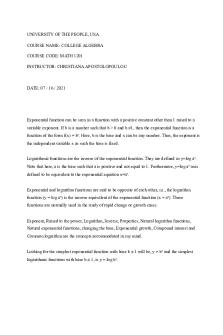Logarithmic Decrement. Pdf showing logarithmic decrement. PDF

| Title | Logarithmic Decrement. Pdf showing logarithmic decrement. |
|---|---|
| Course | Mechanical Vibration and Measurement |
| Institution | University of Technology Sydney |
| Pages | 6 |
| File Size | 298.8 KB |
| File Type | |
| Total Downloads | 28 |
| Total Views | 126 |
Summary
Logarithmic Decrement. Pdf showing logarithmic decrement....
Description
Logarithmic Decrement Background When undergoing damped free vibration, an under damped system will oscillate with an amplitude that decreases over time. We derived the time response as:
Where:
Logarithmic Decrement The rate at which the amplitude of the damped free response decreases over time is called the logarithmic decrement
Deriving the Logarithmic Decrement It is defined as the natural logarithm of the ratio of any two successive peaks of the response. Let us calculate the value of the response oscillation:
at two points in time,
The ratio of the two values is calculate as:
1
and
, that correspond to successive peaks in
Because the times
and
correspond to peaks in the oscillation, the time between them can be easily calculated from
the frequency of damped vibration
:
From this we can determine that:
This means the trigonometric terms cancel, as well as X, leaving us with:
Define the logarithmic decrement as δ:
This shows that the amount that the peaks of the response reduce with every oscillation is a function of the damping ratio ζ.
Small value approximation For smaller values of damping (
) the logarithmic decrement can be fairly well approximated as:
Lets plot the relationship between δ and ζ:
2
log_dec_fun = @(zeta) (2*pi*zeta)./sqrt(1-zeta.^2); log_dec_approx = @(zeta) 2*pi*zeta; figure; axes; hold all fplot(log_dec_fun,[0 0.9],'linewidth',2); fplot(log_dec_approx,[0 0.9],'--','linewidth',2); legend('Logarithmic Decrement','Logarithmic Decrement - approximated','Location','NW'); xlabel('Damping Ratio (\zeta)'); ylabel('Logarithmic Decrement (\delta)'); grid('on'); title('Logarithmic Decrement as function of Damping Ratio');
Both ζ and δ are dimensionless values. If one is known, then the other can be calculated from it.
Logarithmic Decrement of multiple cycles Logarithmic decrement is very useful as it allows us to estimate a system's damping from the decay of successive peaks. For a system with very little damping, trying to measure the decrease between to successive peaks in the response can be difficult. Instead it may be preferable to measure the decay after a number of oscillations. Fortunately the logarithmic decrement generalises to multiple oscillations. If we measure the amplitude of the peaks that have m periods of oscillation between them, the logarithmic decrement can be calculated as:
3
Simulation Lets define the system %% System parameters m = 1; % mass (kg) k = 20; % spring stiffness (N/m) c = 1; % damping (N.s/m) %% Initial conditions x0 = 1.0; % initial displacement (m) xd0 = 0.0; % initial velocity (m/s) From this we are able to determine much about the response, even before plotting it: %% Calculate natural frequency wn = sqrt(k/m); %% Calculate critical damping coefficient cc = 2*m*wn; %% Calculate damping ratio zeta = c / cc; % damped natural frequency wd = wn*sqrt(1-zeta^2); Now lets plot the response using the analytical solution %% Calculate analytical solution C1 = x0; C2 = (xd0 + zeta*wn*x0)/wd; X = sqrt(C1^2+C2^2); PHI = atan2(C2,C1); x_fun = @(t) X.*exp((-zeta*wn).*t).*cos(wd.*t-PHI); %% Now plot the response figure; axes; hold all fplot(x_fun,[0 10]); xlabel('time [s]'); ylabel('x(t) [m]'); grid('on'); title('Free response calculated using analytical solution'); Now analyse the logarithmic decrement %% Extract value at successive peaks t1 = 2*pi/wd; t2 = t1 + 2*pi/wd;
4
X1 = x_fun(t1); X2 = x_fun(t2); scatter([t1 t2],[X1 X2],'filled');
%% Calculate logarithmic decrement and approximate the damping ratio delta = log(X1/X2); zeta_estimate = delta / (2*pi); We compare the actual damping ratio with that calculated using logarithmic decrement disp(sprintf('Actual damping ratio is %1.4f',zeta)); Actual damping ratio is 0.1118
disp(sprintf('Estimated damping ratio is %1.4f',zeta_estimate)); Estimated damping ratio is 0.1125
Links and references Links
5
https://en.wikipedia.org/wiki/List_of_trigonometric_identities https://en.wikipedia.org/wiki/Logarithmic_decrement https://en.wikipedia.org/wiki/Damping_ratio
Relevant textbooks Rao, Mechanical Vibrations, 5th Edition, Chapters 2.6.
6...
Similar Free PDFs
Popular Institutions
- Tinajero National High School - Annex
- Politeknik Caltex Riau
- Yokohama City University
- SGT University
- University of Al-Qadisiyah
- Divine Word College of Vigan
- Techniek College Rotterdam
- Universidade de Santiago
- Universiti Teknologi MARA Cawangan Johor Kampus Pasir Gudang
- Poltekkes Kemenkes Yogyakarta
- Baguio City National High School
- Colegio san marcos
- preparatoria uno
- Centro de Bachillerato Tecnológico Industrial y de Servicios No. 107
- Dalian Maritime University
- Quang Trung Secondary School
- Colegio Tecnológico en Informática
- Corporación Regional de Educación Superior
- Grupo CEDVA
- Dar Al Uloom University
- Centro de Estudios Preuniversitarios de la Universidad Nacional de Ingeniería
- 上智大学
- Aakash International School, Nuna Majara
- San Felipe Neri Catholic School
- Kang Chiao International School - New Taipei City
- Misamis Occidental National High School
- Institución Educativa Escuela Normal Juan Ladrilleros
- Kolehiyo ng Pantukan
- Batanes State College
- Instituto Continental
- Sekolah Menengah Kejuruan Kesehatan Kaltara (Tarakan)
- Colegio de La Inmaculada Concepcion - Cebu

![Solutions 6.4 [Logarithmic Functions ]](https://pdfedu.com/img/crop/172x258/1o20d9djyrn0.jpg)













